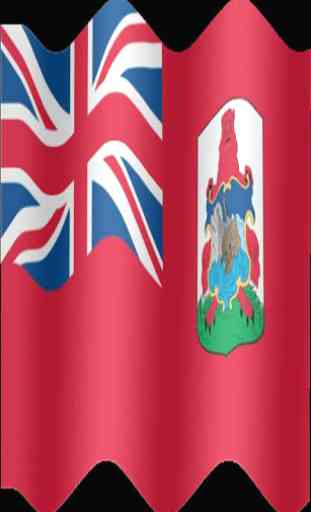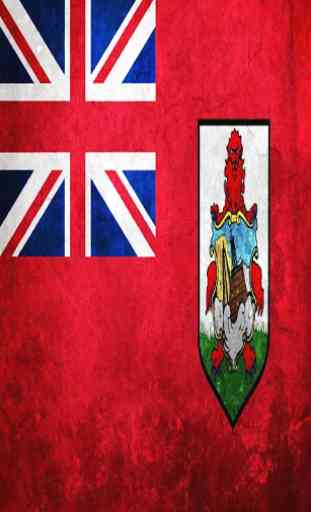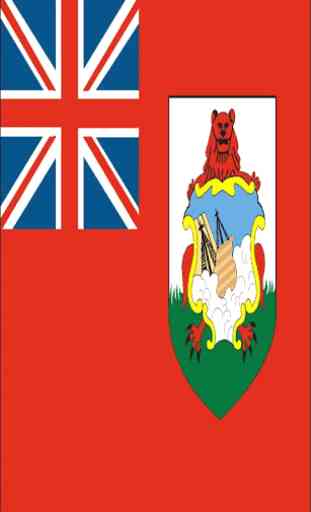Bermuda Flag
The flag is unusual for a British overseas territory in that it is used on land in a red ensign form; most other British overseas territories use a version of the blue ensign for general use ashore. Bermuda's use of a red ensign on land is in keeping with Canada (pre-1965) and the Union of South Africa (pre 1928), both of which used red ensigns ashore as local flags in the early part of the 20th century. Bermuda's flag is an appropriate civil ensign for vessels registered on the Bermuda portion of the British Register, by virtue of the Bermuda Merchant Shipping Act of 2002. The Governor of Bermuda uses a Union Flag defaced with the coat of arms, a design traditional for Governors of the British overseas territories. For the state ensign, a blue ensign is used.
Bermuda consists of about 138 islands and islets, with all the major islands aligned on a hook-shaped, but roughly east-west, axis and connected together by road bridges. Despite this complexity, Bermudians usually refer to Bermuda as "the island". In terms of terrain, the islands are composed of low hills separated by fertile depressions, and interspersed with a complex set of waterways.
The inhabited island chain is actually the southern sector of a circular pseudo-atoll, the remainder of the coral ring being submerged or inter-tidal reefs (Bermuda was formed volcanically but is not a true atoll). As a result the northern shores of inhabited islands are relatively sheltered, whilst the southern shores are exposed to the ocean swell. Consequently most of the best beaches are on the southern shore.
Bermuda has a subtropical climate, with hot and humid weather from spring through fall, however daytime temps fall to the upper 60s °F in wintertime, with wintertime lows of around 58°F. Rarely do temperatures fall below 55°F. The water also cools down into the 60s °F in the wintertime. Humidity remains high in the wintertime. The Gulf Stream does help Bermuda maintain a subtropical climate, despite the latitude being equal to the Carolinas in the United States. For almost half the year (April to Sept) the UV index is over 8.
Bermuda was first settled in 1609 by shipwrecked English colonists headed for the infant English colony of Virginia. The first industry on the islands was fruit and vegetable cultivation to supply the early American colonies. The islands took a carefully unofficial role during the American War of Independence, with much of Washington's armaments coming from a covert (and likely locally complicit) raid on the island's armoury. After US independence and during the Napoleonic wars, Great Britain found itself without access to the ports now on the US east coast. Because of this situation and Bermuda's convenient location between British Canada and Britain's Caribbean possessions, Bermuda became the principal stopover point for the British Royal Navy's Atlantic fleet, somewhat similar to Gibraltar.
The American Civil War and American Prohibition both added considerably to the island's coffers, with Bermuda forming an important focal point in running the blockades in both cases. During the Second World War, a large US air base was built on the islands and remained operational until 1995, and Bermuda served as the main intercept centre for transatlantic cable messages to and from occupied Europe.
Tourist travel to Bermuda to escape North American winters first developed in Victorian times. Tourism continues to be important to the island's economy, although international business has surpassed it in recent years. Bermuda has developed into a highly successful offshore financial centre. A referendum on independence was soundly defeated in 1995. For many, Bermudian independence would mean little other than the obligation to staff foreign missions and embassies around the world, which can be an onerous obligation for Bermuda's small population.
Bermuda consists of about 138 islands and islets, with all the major islands aligned on a hook-shaped, but roughly east-west, axis and connected together by road bridges. Despite this complexity, Bermudians usually refer to Bermuda as "the island". In terms of terrain, the islands are composed of low hills separated by fertile depressions, and interspersed with a complex set of waterways.
The inhabited island chain is actually the southern sector of a circular pseudo-atoll, the remainder of the coral ring being submerged or inter-tidal reefs (Bermuda was formed volcanically but is not a true atoll). As a result the northern shores of inhabited islands are relatively sheltered, whilst the southern shores are exposed to the ocean swell. Consequently most of the best beaches are on the southern shore.
Bermuda has a subtropical climate, with hot and humid weather from spring through fall, however daytime temps fall to the upper 60s °F in wintertime, with wintertime lows of around 58°F. Rarely do temperatures fall below 55°F. The water also cools down into the 60s °F in the wintertime. Humidity remains high in the wintertime. The Gulf Stream does help Bermuda maintain a subtropical climate, despite the latitude being equal to the Carolinas in the United States. For almost half the year (April to Sept) the UV index is over 8.
Bermuda was first settled in 1609 by shipwrecked English colonists headed for the infant English colony of Virginia. The first industry on the islands was fruit and vegetable cultivation to supply the early American colonies. The islands took a carefully unofficial role during the American War of Independence, with much of Washington's armaments coming from a covert (and likely locally complicit) raid on the island's armoury. After US independence and during the Napoleonic wars, Great Britain found itself without access to the ports now on the US east coast. Because of this situation and Bermuda's convenient location between British Canada and Britain's Caribbean possessions, Bermuda became the principal stopover point for the British Royal Navy's Atlantic fleet, somewhat similar to Gibraltar.
The American Civil War and American Prohibition both added considerably to the island's coffers, with Bermuda forming an important focal point in running the blockades in both cases. During the Second World War, a large US air base was built on the islands and remained operational until 1995, and Bermuda served as the main intercept centre for transatlantic cable messages to and from occupied Europe.
Tourist travel to Bermuda to escape North American winters first developed in Victorian times. Tourism continues to be important to the island's economy, although international business has surpassed it in recent years. Bermuda has developed into a highly successful offshore financial centre. A referendum on independence was soundly defeated in 1995. For many, Bermudian independence would mean little other than the obligation to staff foreign missions and embassies around the world, which can be an onerous obligation for Bermuda's small population.
Category : Personalization

Related searches




